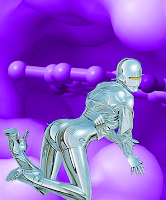We humans are fascinated by our evolutionary origins and by speculation about our possible future fate. In this blog post I want to further explore our place in the universe and the question: exactly what type of life form are we humans?
I
previously shared a diagram that illustrates the diversity of life in the known universe. My construction of that diagram was inspired by my recent conversations with
Gohrlay. Gohrlay is a great source of information about such matters because of her many contacts with life forms that exist beyond our dingy little planet. Here's that diagram again (below):
 |
| fanciful depiction of the pek (source) |
Most life forms in the universe are artificial life forms that are composed of non-biological components such as
nanites. According to Gohrlay, we humans are actually Sedronites (see the gray circle towards the center of the diagram, above). Sedronites are hybrid organisms that are part biological and part artificial because of our
zeptite endosymbionts.
According to Gohrlay, there are far more species of Sedonites than "plain Eukaryotes" in the known universe. The term "known universe" means "known to the pek". The
pek are a type of artificial life that has been spreading through the universe for a couple billion years, so they have explored many galaxies.
When the pek visit planets like Earth, they "seed" those planets with zeptites. Zeptites are very small devices that can assemble together and form artificial life forms or they can take up residence inside biological organisms. There are no "plain Eukaryotes" on Earth because all biological organisms on Earth are hybrid organisms, mixtures of biological and zeptite components.
Below, I provide a detailed summary of our human evolutionary tree.
Our bodies contain eukaryotic cells with cell nuclei. In the diagram above, the red part includes the prokaryotic bacteria of earth, organisms that are composed of non-nucleated cells and, according to Gohrlay, also zeptite components.
We think of bacteria as being small life forms, but artificial life forms composed of
nanites,
femtobots and
zeptites can be far smaller.
Metazoa
Among all of the life forms on Earth that have eukaryotic cellular components, we humans are
metazoans. There are about 1.5 million metazoan species on Earth: we humans are among the
bilateria, a very successful form of animal. Unlike the fungi, we animals specialize in mobility. During the past 100,000 years humans have spread over the entire surface of planet Earth and we dream of traveling to new worlds, even distant planets in orbit around far stars.
As
chordates, we humans have a hollow dorsal nerve cord during our embryonic development, which bodes well for the development of a sophisticated central nervous system.
Humans are among the 64,000
vertebrate species. As bipeds, be have a specialized vertebral column to support our upright body posture and house our spinal cord. However, we are still classified among the
tetrapods. Our bipedalism is only a recent evolutionary invention.
Humans are among the animals that never produce an egg shell and that give birth to live young. As placental
mammals, humans evolved to have large babies that are born quite helpless and dependent on breast milk.
Of the thousands of mammalian species, about 600 are primates.
Primates tend to have longer juvenile periods than other mammals and ample opportunities for learning during social interactions with older members a social group. Humans are
apes, a clade of primates with no tail, an evolutionary innovation that dates to about 25,000,000 years ago.
 |
| Old World monkeys and Apes |
The taxonomic "
family" of the human species has evolutionary origins that can be traced back to a common ancestor that lived about 15,000,000 years ago.
The human genus (
Homo) includes several extinct bipedal apes such as
Australopithecus, dating back about 4,000,000 years.
The earliest stone tools are attributed to members of the genus
Homo who lived about 2,600,000 years ago.
From about 2,000,000 years ago,
Homo erectus spread out of Africa and might have had a fairly "modern" hunter-gatherer lifestyle.
New members of the
Homo genus continue to be found.
Homo naledi is a recently identified, small-brained biped that was found about 10 years after
Homo floresiensis.
So far the
Denisovans are mostly known through genetic analysis of a few bone fragments.
Fully modern human skeletal remains have been found that date back about 200,000 years.
Our "
modern human" ancestors spread out from Africa and inter-bred with other large-brained members of the
Homo genus (
Neanderthals and Denisovans) before those members of the genus became extinct.
For the
Exode Trilogy, I have fun imagining that space aliens played a role in creating the human species.
We can imagine that primates were taken away from Earth about 7,000,000 years ago and "cultured" on planets of the Galactic Core by the pek. Later, the
Grendels transferred genetically engineered gene combinations back into the primate population of Earth, resulting in the human species.
It is fun to imagine that many other human-like primate variants have been engineered and spread through the galaxy. I refer to all of these human-like creatures as Sedronites, but the original Sedronintes were produced about 6,000,000 years ago by the pek. Some of those first Sedronites "abandoned" their physical existence as biological organisms and merged into the
Sedronic Domain.
Next: more on
the origins of the science fiction genre.


























No comments:
Post a Comment